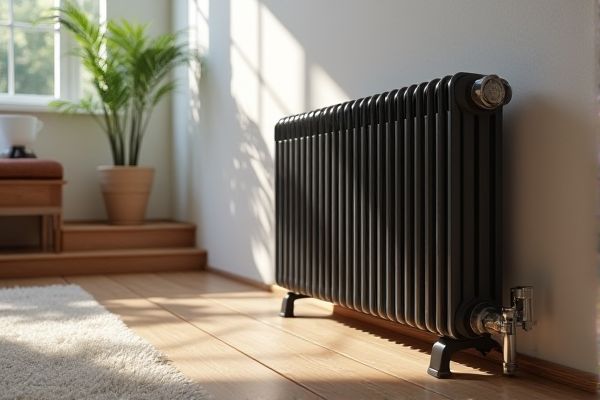
A kick plate heater offers targeted, energy-efficient warmth by heating the air near the floor, ideal for smaller spaces, while a radiator provides broader heat distribution through convection, suitable for larger rooms. Discover which heating option best suits your needs by reading the rest of the article.
Table of Comparison
| Feature | Kick Plate Heater | Radiator |
|---|---|---|
| Heating Method | Convection and radiant heat from baseboard placement | Radiant heat from hot water or electric elements |
| Installation Location | Typically installed at baseboards near the floor | Mounted on walls or freestanding units |
| Heat Distribution | Delivers heat at foot level, warming the floor area first | Distributes heat evenly through room via surface radiance |
| Energy Efficiency | Efficient for localized heating, quick warm-up times | Generally efficient, best when integrated with central heating |
| Space Requirements | Saves wall space, unobtrusive near floor | Requires wall or floor space, can be bulky |
| Maintenance | Low maintenance, easy to clean | Requires regular bleeding and occasional servicing |
| Cost | Moderate upfront cost, low operating costs | Variable cost depending on type (water or electric) |
| Best Use | Supplemental or zone heating in small to medium rooms | Main heating source in larger rooms or whole-home systems |
Introduction to Kick Plate Heaters and Radiators
Kick plate heaters are compact heating devices installed at the base of walls or cabinets, designed to provide targeted warmth in small spaces such as bathrooms or kitchens. Radiators operate by circulating hot water or steam through metal panels, radiating heat evenly across larger rooms. Both serve essential functions in home heating systems, but their design and heat distribution methods cater to different spatial and efficiency needs.
How Kick Plate Heaters Work
Kick plate heaters work by using electric heating elements hidden within a slim, low-profile panel installed at the base of doors or walls, where they warm the air near the floor. Unlike radiators, which rely on convection currents created by hot water or steam circulating through metal pipes or fins, kick plate heaters provide direct, localized heat often controlled by a built-in thermostat. You can benefit from their efficient, space-saving design that delivers immediate warmth in specific areas without the bulk of traditional radiators.
How Radiators Function
Radiators function by heating air through convection; hot water or steam circulates inside the metal panels, warming surrounding air that rises and circulates throughout the room. Unlike kick plate heaters that provide localized heat near the floor, radiators distribute warmth more evenly across larger spaces. Understanding this process helps you choose the best heating solution for efficient and comfortable home temperature control.
Efficiency Comparison: Kick Plate Heater vs Radiator
Kick plate heaters deliver targeted warmth by heating air close to the floor, resulting in faster comfort and lower energy usage compared to traditional radiators that rely on convection to warm an entire room gradually. Radiators often consume more energy due to their larger surface area and slower heat distribution, whereas kick plate heaters optimize efficiency by focusing heat where your feet and lower body need it most. Choosing a kick plate heater can enhance energy efficiency and reduce heating costs in spaces requiring quick, zoned heating solutions.
Installation Process: Kick Plate Heater vs Radiator
The installation process for a kick plate heater is typically simpler and faster, as it requires mounting near the floor and connecting to existing electrical wiring with minimal modifications. In contrast, radiator installation may involve plumbing work to connect to a central heating system, which can be more complex and time-consuming, especially in older buildings. Kick plate heaters are ideal for quick upgrades or supplemental heating, while radiators often serve as integral components in comprehensive heating systems.
Space and Design Considerations
Kick plate heaters are compact and discreet, ideal for tight spaces or under cabinets where traditional radiators may not fit, enhancing room aesthetics without obstruction. Radiators typically require more wall space and can dominate room design due to their size and visible profiles. Choosing a kick plate heater supports minimalist and modern interiors by integrating heating elements seamlessly, whereas radiators contribute to a more classical or industrial look with their bulkier presence.
Heating Performance and Coverage
Kick plate heaters provide focused, efficient heating by targeting lower wall areas, making them ideal for small to medium-sized rooms with localized warmth needs. Radiators offer broader heat distribution through convection, effectively warming larger spaces and maintaining consistent room temperatures. Your choice depends on whether you prioritize quick, direct heat or comprehensive coverage throughout the room.
Energy Consumption and Costs
Kick plate heaters typically consume less energy than traditional radiators due to their focused heating design and fast heat-up times, resulting in lower operational costs. Radiators often require more energy to heat entire rooms evenly, leading to higher electricity or fuel expenses over time. Choosing a kick plate heater can offer improved energy efficiency and cost savings in smaller spaces or localized heating applications.
Maintenance and Longevity
Kick plate heaters require minimal maintenance, mainly periodic dusting and occasional inspection of electrical components, contributing to a longer operational lifespan. Radiators might demand more frequent maintenance such as bleeding to remove trapped air and checking for leaks, which can affect their longevity if neglected. Your choice depends on whether you prefer a low-maintenance solution with consistent durability or a traditional heating method needing regular upkeep.
Choosing the Right Heater for Your Space
Kick plate heaters offer direct, low-level warmth ideal for smaller rooms or under cabinets, making them energy-efficient for localized heating. Radiators provide even, widespread heat distribution suitable for larger spaces or entire rooms, maintaining consistent temperatures over time. Choose your heater based on room size, heating needs, and energy consumption preferences to optimize comfort and efficiency.
 homyna.com
homyna.com